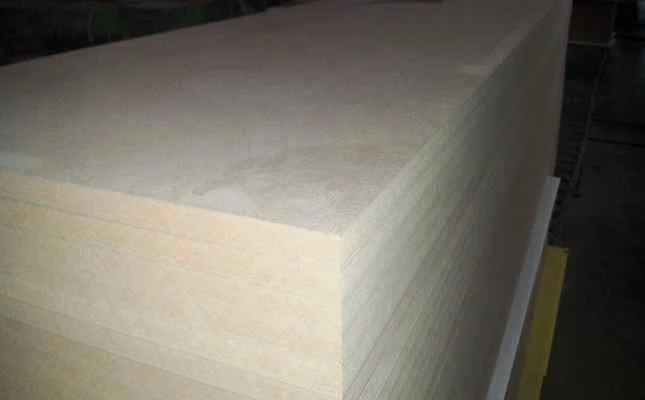The furniture industry chooses MDF as the main material because of its several advantages, including being cheaper than natural (solid) wood, consistent strength and size, stable dimensions, excellent absorption of paint and wood glue, strong screw fastness, excellent substrate for veneers, good shape, able to muffle sound and can not be eaten by flea beetles.
At first glance, the furniture displayed above looks like it is made of plastic, but in fact the basic material for this furniture is MDF Medium Density Fibreboard which is finally processed using paint coating in various colors through the Ultra Violet process.
The visual color of the Ultra Violet process can vary but is uniform in one color for one surface. The example above has 4 color combinations namely white, light gray, pink and dark gray.
The Ultra Violet process can only be used for high density materials like MDF and HDF High Density Fibreboard type materials, it's just that the price is too high unless the product is to be marketed for export abroad, it might be able to cover the cost of the production process.
The Ultra Violet process requires a high time base and it is not possible to adjust the processing speed of each Ultra Violet machine because each machine has a fixed cycle time.
The composition of MDF includes 82% wood fiber, urea formaldehyde resin glue (H2CO), often known as 9% formalin or methanal, 8% water and 1% paraffin.
There are special colored MDF types such as moisture-resistant MDF that has a green color, fire-resistant MDF that is colored red or blue, of course the price will be more expensive than ordinary plain MDF.
The best MDF wood residue materials are Australian and New Zealand radiata pine trees but subsequent developments of other wood materials and waste paper can be used to make MDF.
MDF has weaknesses including:
- MDF can warp (bending) in a humid environment if it is not properly sealed when it is still a standard sheet or cut MDF (WIP).
- Swells and bursts when saturated with water
- Releasing free formalin into the air which is a human carcinogen, especially during the cutting and sanding processes
- Using a knife dulls faster.
It is mandatory for operators of cutting machines and sanding departments to wear breathing apparatus when carrying out this type of MDF process or to use a respirator mask and routinely change the filter every 3 months. The use of MDF processing knives must use a tungsten carbide-edged knife so that the knife does not dull quickly.
MDF has special characteristics that PB doesn't have, especially its density.
Density (ρ) is the ratio between the mass of an object divided by its volume.The standard MDF sheet dimensions are 1220 mm x 2440 mm and a thickness of 1.5 mm to 32 mm.
Is MDF density the same for each thickness?
Based on the experimental results of measuring MDF density at several thicknesses for all types E0, E1, E2, P2, FR and HMR, the MDF density data is obtained as follows:
- Thickness 1.5 mm - 2.4 mm average density 825 Kg/M3
- Thickness 2.5 mm - 3 mm average density 800 Kg/M3
- Thickness 3.1 mm - 6 mm average density 780 Kg/M3
- Thickness 6.1 mm - 12 mm average density 750 Kg/M3
- Thickness 12.1 mm - 18 mm average density 680 Kg/M3
- Thickness 18.1 mm - 25 mm average density 660 Kg/M3
- Thickness 25.1 mm - 32 mm average density 640 Kg/M3
The MDF density value should be the same for each MDF thickness. This reduced density at a greater MDF thickness can be due to the looser mass density of the middle part compared to the surface or the density is not the same between the surface and the middle part of the MDF.
If this is included in the QC standard tolerance category, then all that remains is to continue processing the MDF to the panel furniture production process, but if this is outside the QC tolerance with reference to the quality standards of the MDF maker, then you can complain about this difference in density, maybe during the press process the machine is in temperature conditions and the pressure is less.
This measurement applies to all types: E0, E1, E2, P2, FR and HMR.
Classification E0, E1, E2, P2, FR and HMR
1. Classifications E0, E1 and E2 published by the International Composite Standards Board (ICBES) and the European Panel Industry, divide the classification based on the level of formaldehyde emission.
- E0 : Formaldehyde emission less than 3 milligrams per 100 grams.
- E1 : Formaldehyde emissions between 3 and 9 milligrams per 100 grams
- E2 : Formaldehyde emissions between 9 to 30 milligrams per 100 grams
- CARB P1 : Formaldehyde emission 0.08 ppm
- CARB P2 : Formaldehyde emission of 0.05 ppm, has a higher emission standard than the European standard E0
MDF FR and MDF HMR formaldehyde emissions follow one of the 2 standards above, namely E2, E1, E0 and P2.
3. The JIS Japanese Industrial Standard Classification through the JAS Japanese Agricultural Standard institution has determined the lowest formaldehyde emission below 0.005 mg with the code F*, F** or F***.
Loading posts



